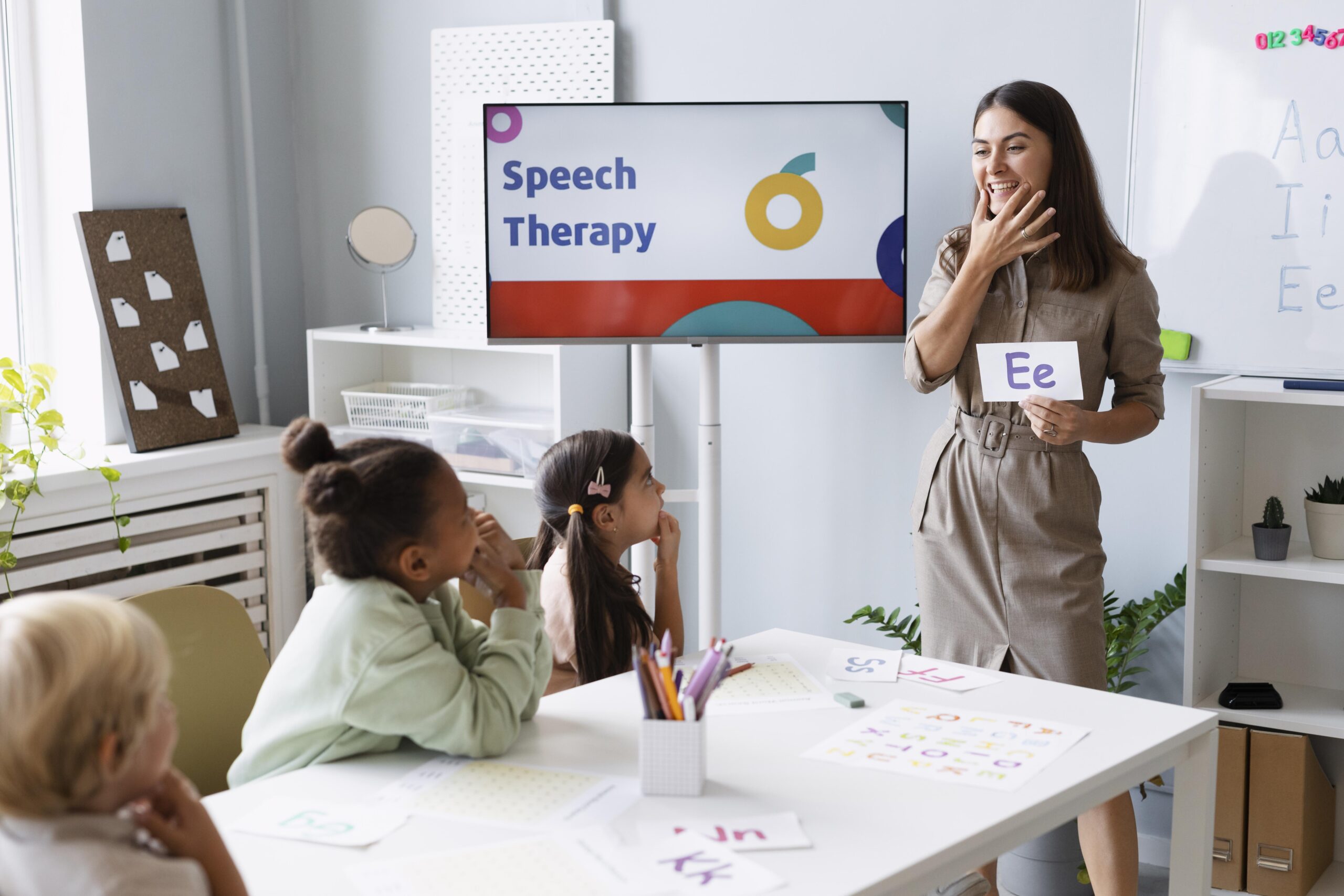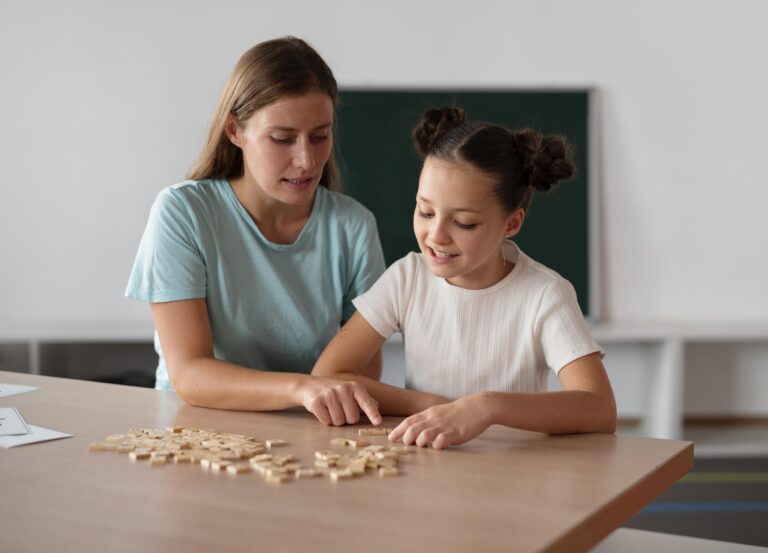A Guide to Understanding Speech and Language Development
Speech and language development is an amazing process that unfolds as children grow. From their first babbles to forming complex sentences, each stage marks a significant milestone. This journey of communication is vital, impacting not only their ability to express themselves but also their cognitive development, social interactions, and overall success in life.
While this progression typically follows a predictable pattern, it’s essential to remember that every child is unique, and there can be considerable variation in their developmental pace. In a neurodiverse school setting, it’s especially important to recognize and celebrate these differences. As parents, caregivers, and educators, we might sometimes find ourselves worrying if a child in our lives isn’t meeting specific communication milestones.
Perhaps they’re struggling to pronounce certain sounds, or maybe they seem slower to understand language compared to their peers. This is perfectly normal, and many factors can contribute to variations in speech and language development, including things like personality, exposure to language, and underlying medical conditions.
Table Of Contents:
- Unlocking Language: A Look at How It Develops
- The Autism Connection: Speech and Language Development
- Delays in Speech and Language Development: Potential Causes
- Enhancing Communication: Activities That Encourage Speech and Language Development
- When Professional Guidance Is Needed: Seeking Expert Support
- Conclusion
Unlocking Language: A Look at How It Develops
Understanding how speech and language typically develop can be incredibly helpful for those who care for children. From birth, babies are already attuned to the sounds around them. They begin to recognize familiar voices, like their parents, and start to differentiate between the various sounds that make up human speech.
By 6 months old, babies start to focus on the specific speech sounds of their native language. This remarkable ability to zero in on familiar sounds sets the stage for their language comprehension to grow. Researchers at the University of Texas at Dallas are studying how babies learn languages.
They have been tracking brain responses and discovered measurable progress in babies’ speech development. They found measurable differences in babies’ brains that indicate the earliest stages of language development.
Milestones in Speech and Language Development
Experts at The National Institute on Deafness and Other Communication Disorders emphasize that the first three years of life represent a truly important period for developing speech and language skills. It’s during this time that the brain undergoes rapid growth, and consistent exposure to sounds, sights, and language is like providing the essential nutrients for communication to blossom.
There are well-established developmental milestones associated with speech and language acquisition, offering helpful benchmarks to observe as children grow. For instance:
| Age | Speech Milestones | Language Milestones |
|---|---|---|
| Birth to 6 Months | Cooing Babbling Turning toward sounds | Recognizing familiar voices Responding to their name |
| 7 to 12 Months | Reduplicated babbling (“mamama,” “dadada”) Using a wider variety of sounds in babbling Possibly saying their first word | Responding to simple requests (e.g., “wave bye-bye”) Understanding “no” |
| 1 to 2 Years | Rapidly expanding vocabulary Using two-word phrases (“more milk,” “go outside”) Imitating sounds and words | Understanding simple questions Following simple directions Pointing to familiar objects |
| 3 to 4 Years | Speaking in longer sentences (3-4 words or more) Telling simple stories Asking “why” questions | Understanding more complex sentences Following multi-step instructions Recognizing colors and shapes |
| 4 to 5 Years | Using more complex grammar and sentence structures Telling stories with clear beginnings, middles, and ends Pronouncing most sounds correctly | Engaging in conversations Understanding abstract concepts Using language to express thoughts and feelings |
As you look through these general milestones, it’s easy to see how speech and language development unfold naturally over the first five years of a child’s life. It is important to remember these milestones serve as general guidelines rather than rigid benchmarks. Just like you might see between a 3-year-old and a 4-year-old’s milestones, variations in individual development are expected.
The Autism Connection: Speech and Language Development
Now, let’s talk about autism. Navigating life with Autism Spectrum Disorder often involves unique challenges, particularly in the areas of speech and language development. Children on the autism spectrum frequently experience differences in these areas compared to typically developing peers. These differences are a core characteristic of autism, often serving as one of the key ways in which autism presents itself.
Some autistic children might start talking later than expected or struggle with specific aspects of language, like using pronouns correctly or understanding social cues in conversation. While these challenges can impact a child’s communication, the good news is that early identification can make a world of difference. Addressing speech and language difficulties at an early age provides a greater chance to support their communication skills and overall development.
Signs to Watch For in Young Children
As mentioned earlier, it’s crucial to understand that the timeline for speech and language development varies among children. That being said, there are general indicators that might point to potential difficulties requiring further assessment by professionals, especially if a child:
- Doesn’t babble or coo by 9 months of age.
- Struggles to make eye contact or engage in back-and-forth interactions.
- Doesn’t respond consistently to their name being called.
- Relies heavily on gestures to communicate instead of using words.
- Has difficulty understanding simple instructions or questions.
- Loses previously acquired language skills. For example, if a child used to say “mama” or “dada” but has stopped doing so.
While it’s important to note that these signs don’t always point definitively to a problem, they can warrant a conversation with a medical professional. A qualified speech-language pathologist (SLP) can conduct a thorough assessment, offering personalized recommendations based on the child’s individual needs.
Delays in Speech and Language Development: Potential Causes
Just as speech and language development follows a natural progression, there are various reasons why a child might experience delays along the way. Some of the most common causes include:
Hearing Problems
A recent study from Vanderbilt University highlights that children with developmental disabilities might not be getting the necessary hearing evaluations they need. Untreated hearing loss, no matter how mild, has a direct impact on how children learn to process and use spoken language.
When a child cannot hear clearly, their ability to mimic sounds and understand speech is hindered, potentially leading to delays in their language acquisition. It’s always crucial to rule out any hearing issues.
Simple tests can often determine if a child is experiencing difficulty with their hearing, allowing for appropriate interventions such as ear tubes to address any existing problems.
Developmental Language Disorder (DLD)
According to The National Institute on Deafness and Other Communication Disorders, Developmental language disorder (DLD) represents a specific type of language disorder characterized by difficulties in understanding and using language.
Children with DLD might exhibit a range of challenges, such as using grammatically incorrect sentences or having trouble understanding and using words in the correct context. DLD can impact various aspects of communication, including listening, speaking, reading, and writing.
The exact causes of DLD are complex and still under investigation, but experts believe genetic factors and differences in brain structure or function could contribute to this language disorder. These genetic factors may include a family history of language problems or developmental language disorders.
Other Factors That Can Impact Speech & Language Development
Beyond medical conditions, a range of factors can affect how children learn and use language:
- Limited Language Exposure: Exposure to language from an early age lays the foundation for communication skills. Spending time talking, reading, and singing with young children provides a rich learning environment for speech and language development. It’s why encouraging caregivers to engage in frequent and meaningful conversations with infants and young children is so vital for healthy language growth.
- Learning Multiple Languages: For children growing up in multilingual environments, acquiring multiple languages is a normal part of their development. Although it may temporarily appear that they develop their vocabulary at a slightly slower pace initially, they catch up. Bilingualism offers considerable cognitive benefits. It fosters their understanding and appreciation of diverse languages and cultures from an early age.
- Premature Birth: Children born prematurely often experience developmental delays in several areas, including speech and language. Preemies may face challenges catching up with their peers regarding communication milestones. Early intervention and specialized support are often recommended. Premature birth can also lead to other medical complexities that impact speech and language development.
- Oral Motor Issues: Problems with muscle control in the mouth, lips, and tongue can affect speech sound production and clarity, leading to articulation difficulties. Seeking evaluation and support from a speech-language pathologist specializing in oral motor therapy can be incredibly beneficial. For example, a child may struggle with specific speech sounds due to weakness or coordination issues.
Because several factors contribute to delays in speech and language development, it is crucial to seek guidance from healthcare providers and trained professionals. Early identification and tailored interventions can help to provide support. Seeking help from professionals can help answer simple questions that parents may have. For example, parents often ask, “What if my child doesn’t reach the typical language milestones?” It’s important to consult with a healthcare professional if you have concerns about your child’s speech and language development.
Enhancing Communication: Activities That Encourage Speech and Language Development
The best way to encourage children’s communication is to engage them in interactive activities:
- Read Together: Make reading aloud a part of your daily routine. Choose books with vibrant pictures and engaging stories. When reading, ask your child questions about the story or have them point to different pictures.
- Sing Songs: Children often find songs and rhymes incredibly catchy, making them excellent tools for teaching language skills. The repetitive nature of songs helps with memorization and provides an opportunity to introduce new vocabulary in a fun, interactive manner. Songs and rhymes introduce children to the rhythm and patterns of language.
- Describe Daily Routines: Whether you’re cooking together, going for a walk, or giving your child a bath, take those opportunities to describe what you’re doing step by step. Talk about the objects you see and use, and encourage them to repeat the words you’re using.
- Play Games: Engage in simple games with your child, like “Simon Says” (which promotes listening skills and following directions) or age-appropriate board games that encourage turn-taking and language use. Playing games is a fun and interactive way to promote language development.
- Create a Language-Rich Environment: It’s about making every interaction count. Talking, singing, reading, and even narrating your actions all contribute to exposing your child to the richness of language, boosting their vocabulary and communication abilities. Surround them with language-rich activities, and don’t be afraid to use “big” words – children often enjoy learning new and unusual vocabulary. Encourage them to ask questions about what they see and hear, promoting curiosity and language development.
When Professional Guidance Is Needed: Seeking Expert Support
While engaging in these everyday activities can foster communication skills in remarkable ways, there are instances where seeking professional guidance from speech-language pathologists (SLPs) or other health professionals can provide valuable support.
Speech-language pathologists (SLPs), for example, play a crucial role in assessing and treating a range of communication disorders, including delays in speech and language development, articulation difficulties, fluency disorders (like stuttering), and social communication challenges. They work with children to address these specific areas of concern and tailor interventions to their unique strengths and areas needing support.
Pediatricians and family physicians also play a key role in identifying potential delays during well-child checkups, often referring families to specialized professionals like SLPs for more in-depth assessments and treatment. In addition to SLPs, other professionals who can help include developmental psychologists and audiologists.
A developmental psychologist specializes in child development and can assess cognitive and social-emotional factors that might be influencing language development. Audiologists are healthcare professionals specifically trained to measure hearing loss and identify any hearing problems that might be affecting a child’s ability to hear and process sounds. If necessary, they can recommend group therapy, individual therapy, or assistive listening devices.
Conclusion
Speech and language development is a fascinating journey that unfolds differently for each child. By understanding the typical milestones, recognizing potential signs of delay, addressing concerns proactively, providing a nurturing environment rich in language and communication, and seeking professional guidance when needed, we can play a crucial role in nurturing a child’s communication skills and setting them up for success.




